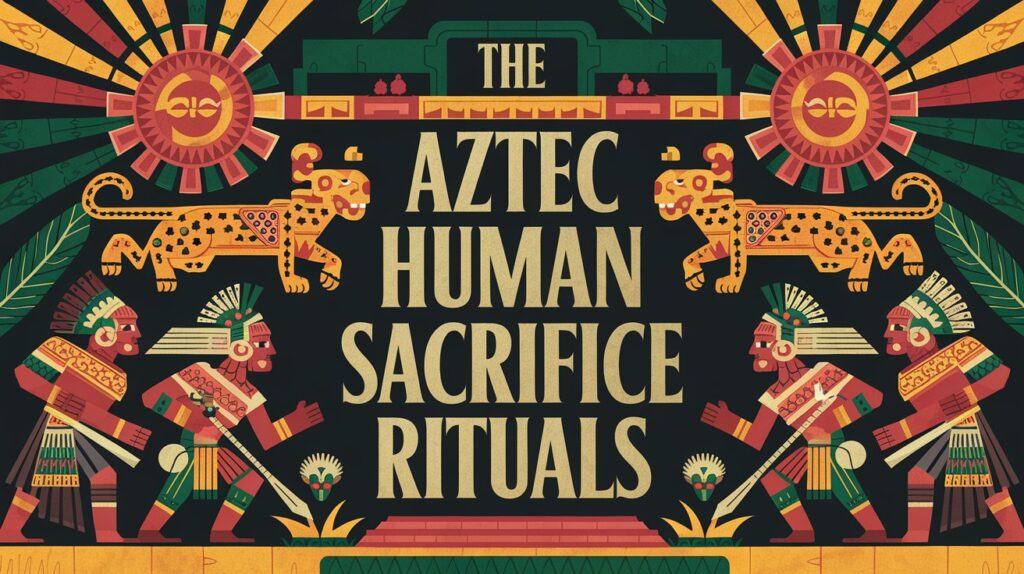The Aztec Empire’s Human Sacrifice Rituals

The Aztec Empire, which flourished in Mesoamerica from the 14th to the 16th century, is often remembered for its remarkable cultural achievements and its complex religious practices. Among the most infamous of these practices were human sacrifices, which played a central role in Aztec society. These rituals were deeply intertwined with the Aztec worldview, which held that the gods required nourishment in the form of blood to ensure the continued survival of the universe. This article explores the religious significance of human sacrifice, the methods involved, and the broader societal implications for the Aztecs.
Religious Significance of Human Sacrifice
For the Aztecs, human sacrifice was not just a brutal practice but a sacred and vital act that reinforced the balance of the cosmos. The Aztecs believed that the gods had sacrificed themselves to create the world and maintain the cycle of life. Central to their belief system was the idea that the sun, the most important deity, needed regular offerings to rise each day. Blood, especially human blood, was thought to be the most potent offering.
One of the key deities associated with sacrifice was Huitzilopochtli, the god of war and the sun, who was believed to require human hearts to sustain his strength. Without this nourishment, the sun would not rise, and the world would plunge into darkness. Other deities, like Tlaloc (the god of rain) and Quetzalcoatl (the feathered serpent), were also honored with sacrifices, though these rituals could vary depending on the nature of the deity and the specific ceremonial calendar.
The Rituals and Ceremonies
The Aztec human sacrifice ritual was a highly structured process, often taking place during religious festivals, such as the Toxcatl festival in honor of Tezcatlipoca, or the Panquetzaliztli festival for Huitzilopochtli. These ceremonies were elaborate and conducted in the presence of priests, nobles, and sometimes large crowds, with the central act of sacrifice occurring on top of the Templo Mayor, the great pyramid at the heart of the Aztec capital, Tenochtitlán.
The sacrificial victims were typically prisoners of war, who were chosen for their perceived valor and strength. However, in certain instances, individuals from the Aztec population or neighboring communities could also be selected. Victims were often paraded through the streets in a ceremonial procession before being taken to the temple.
Once at the temple, the victim was placed on an altar, and the priest would use a ceremonial knife made of obsidian to cut open the chest. The heart was then removed while the victim was still alive, and the heart was offered to the gods by holding it up to the sun or by placing it on a stone or vessel. The body was often thrown down the steps of the pyramid, and the blood spilled onto the ground as a symbol of sacrifice and renewal.
The Methods of Sacrifice
The method of sacrifice varied depending on the ritual and the status of the individual being sacrificed. The most well-known form of human sacrifice was the removal of the heart, but there were other methods as well. For example, in some ceremonies, the victim's blood would be drawn by piercing the body with thorns or other sharp objects, and the blood would be collected in vessels.
In some cases, victims were drowned or had their heads removed, with their skulls displayed on the tzompantli (skull rack) as a public symbol of the Aztec people's power and devotion. These practices were not solely acts of violence but were considered to be sacred offerings that fulfilled the divine needs of the gods.
Social and Political Implications
The practice of human sacrifice was not just a religious act but also had profound social and political implications. It played a central role in the Aztec state’s ability to maintain control over its vast empire. The ritual sacrifice of prisoners of war served as a powerful symbol of the Aztec’s dominance over their enemies. Capturing prisoners was an integral part of military campaigns, and the act of sacrificing these prisoners demonstrated the superiority of the Aztec people.
Sacrifice also functioned as a form of social cohesion within Aztec society. The rituals were communal events that brought together various segments of society, from the nobility to the common people, and reinforced shared religious beliefs and values. The spectacle of sacrifice served as both a religious observance and a form of propaganda, ensuring loyalty to the state and its religious institutions.
The End of Human Sacrifice
With the arrival of Spanish conquistadors in the early 16th century, the Aztec Empire came under siege, leading to its eventual downfall in 1521. Spanish chroniclers, such as Bernal Díaz del Castillo, wrote extensively about the Aztec practice of human sacrifice, often portraying it as barbaric and inhuman. This negative perception of Aztec rituals was further reinforced by the Catholic missionaries who sought to convert the indigenous population to Christianity.
Following the conquest, the Spanish authorities banned the practice of human sacrifice, and the Aztec religious system was largely dismantled. However, the legacy of human sacrifice remains a powerful symbol of Aztec culture, and it continues to intrigue scholars and historians around the world.
Conclusion
The human sacrifice rituals of the Aztec Empire were complex, multifaceted, and deeply embedded in the religious and social fabric of their civilization. Far from being senseless violence, these sacrifices were considered a sacred duty to appease the gods and ensure the prosperity of the world. While the practice has been viewed through a modern lens as brutal and barbaric, it is important to understand it within the context of Aztec cosmology, where sacrifice was seen as a necessary and vital act for the continuation of life itself. The enduring fascination with Aztec sacrifice reflects not only the power and grandeur of the Aztec Empire but also the profound ways in which human cultures have sought to understand their place in the universe.



Post Comment